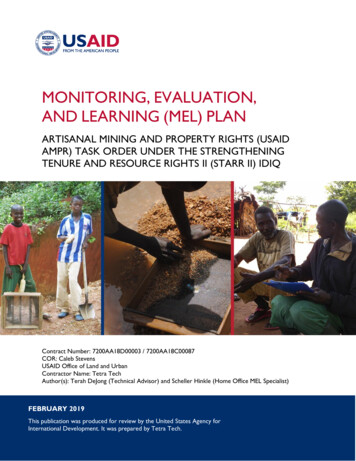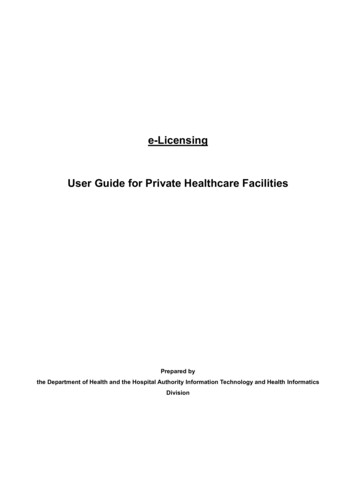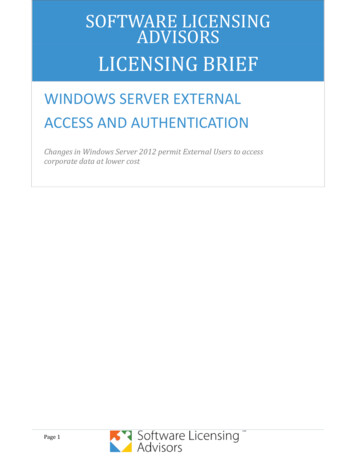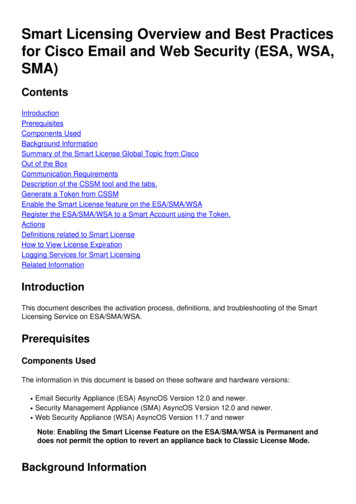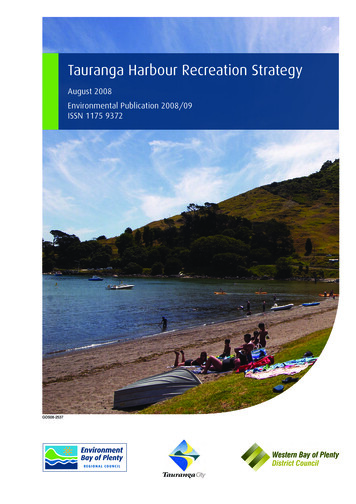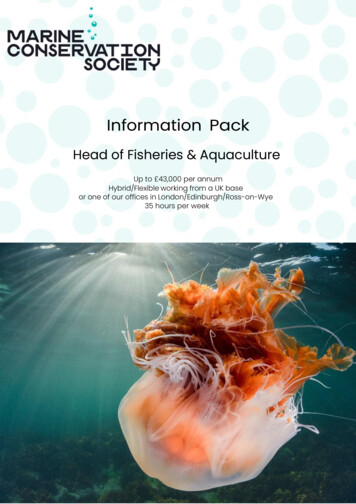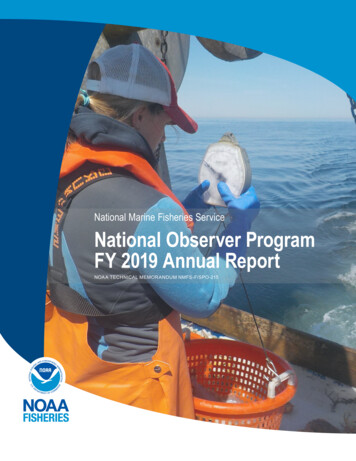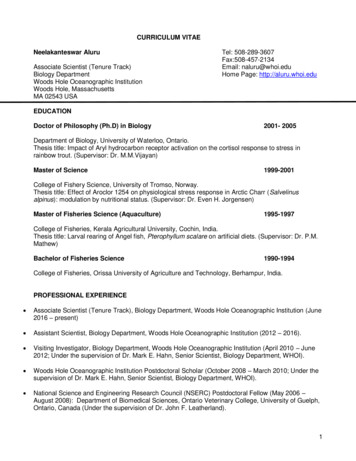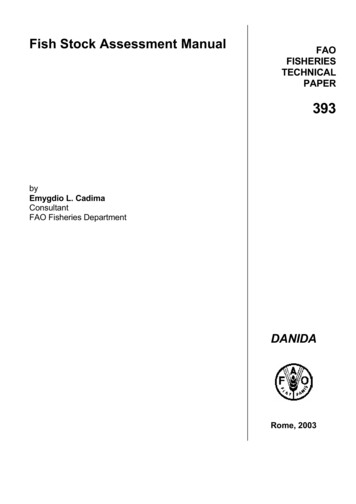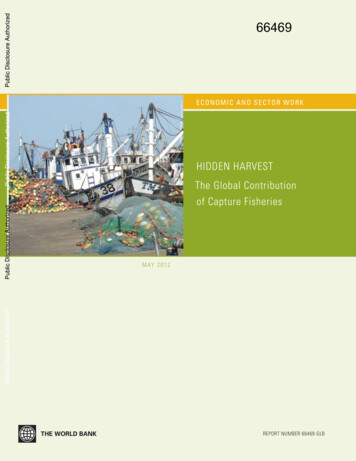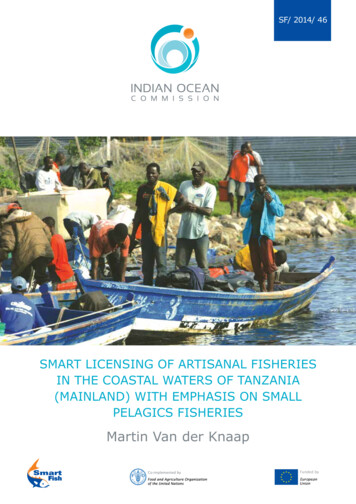
Transcription
SF/ 2014/ 46SMART LICENSING OF ARTISANAL FISHERIESIN THE COASTAL WATERS OF TANZANIA(MAINLAND) WITH EMPHASIS ON SMALLPELAGICS FISHERIESMartin Van der KnaapFunded byEuropeanUnion
The designations employed and the presentation of material inthis information product do not imply the expression of anyopinion whatsoever on the part of Indian Ocean Commissionconcerning the legal or development status of any country,territory, city or area or of its authorities, or concerning thedelimitation of its frontiers or boundaries. The mention ofspecific companies or products of manufacturers, whether or notthese have been patented, does not imply that these have beenendorsed or recommended by Indian Ocean Commission inpreference to others of a similar nature that are not mentioned.The views expressed in this information product are those of theauthor(s) and do not necessarily reflect the views or policies ofIndian Ocean Commission. 2014 Indian Ocean CommissionProgramme for the implementation of aRegional Fisheries Strategy for theEastern and Southern Africa – Indian Ocean RegionSMART LICENSING OF ARTISANAL FISHERIES INTHE COASTAL WATERS OF TANZANIA (MAINLAND)WITH EMPHASIS ON SMALL PELAGICS FISHERIESMartin Van der KnaapIndian Ocean Commission(OCTOBER-NOVEMBER 2013)Blue Tower5th floor, rue de l'InstitutEbene, MauritiusTel : 230 402 6100Fax: 230 466 fish-coi.orgSF/ 2014/ 46“ This publication has been produced with the assistance of the European Union.The contents of this publication are the sole responsibility of the author and canno way be taken to the reflect the views of the European Union.”
TABLE OF CONTENTSLIST OF TABLESLIST OF FIGURESABBREVIATIONSEXECUTIVE SUMMARYSOMMAIRE EXECUTIFINTRODUCTIONMETHODOLOGYPERFORMANCE IN RELATION TO TORPAGE66789121516ANNEX 1 TERMS OF REFERENCEANNEX 2 LIST OF PERSONS METANNEX 3 LIST OF ACTIVITIESANNEX 4 DATA FORM FOR MINI FRAME SURVEY 201332353639ANNEX 5 (DRAFT) SPEECH FOR PERMANENT SECRETARY FORWORKSHOP OPENING (TRANSLATED INTO KISWAHILI)40LIST OF TABLESReview the registration system of artisanal vessel in Tanzania,with particular emphasis on the artisanal vessels targetingTable 1:Registration and license fees for fishing vessels by size category. Source: Fisheries Regulations(For QA/APP/09-11, pp 137-139)small pelagic fish.161. Determine which vessels register, nationally/ local authority.Table 2:Status of registration of marine fishing vessels by region and district. Source: Frame SurveyHow many vessels register as a percentage of total vessel,Report, Table 8in particular for the ringnet fishery.Table 3:Potential revenues from registering and licensing marine fishing vessels by region and districtRegistration of fishing vessels16in 2009Licensing of fishing vessels16Table 4:Number of fishermen per district and the potential revenues from licensing @ US 10 per2. Determine if the license/registration fee is adequate in terms offisherman per year.norms for licence fees in relation to the value of the catch,Table 5.Numbers of fishermen in 2009 and 2013, the potential license revenues and the collectedwhere does the revenue of the licensing system end up andrevenues (license fee at US 10).what percentage is re-invested in the fishery.16Table 6.Numbers of fishermen in 2009 and 2013, the potential license revenues and the collectedAssist in the preparation of procedures to improve licencing andrevenues (theoretical license fee at US 15).registration of the artisanal fishery, in particular the ringnet fishery 24Table 7.Numbers of fishermen in 2009 and 2013, the potential license revenues and the collected1. Detail an improved licencing and registration system for therevenues (theoretical license fee at US 20).artisanal fishery, in particular the ring net fishery, includingTable 8Summary of Pelagic Fisheries Survey 2013aspects of implementation cost, ease of implementation,Table 9Vessel size distribution in Frame Survey of 2009revenue generated and revenue sharing and cost recoveryTable 10. Revenues collected from licensing by Fisheries Departmentoptions available in term of the current legislation.24Table 11. Summary of costs of the Coastal Fisheries Frame Survey in 20092. Provide recommendation on the implementation of the system24and possible changes in policy and legislation (if required)Licensing28LIST OF FIGURESBoat registration28Role of Beach Management Units (BMUs)DISCUSSIONPelagic fisherySMART money operationsEcosystem Approach to Fisheries43030303031Figure 1.Map of Tanzanian coastline, showing the 16 DistrictsFigure 2.Evolution of numbers of fishermen by district along Indian Ocean (Tanzania). Source:Frame Survey report, 2009; Mini frame survey 2013.Figure 3.Annual harvest of small pelagic fish in Tanzanian waters (Mainland)Figure 4.Map of RUMAKI area (WWF-Project) showing fishing grounds for small pelagics (Courtesy:WWF Tanzania).
LISTE DES ABREVIATIONSBMU Beach Management UnitDED District Executive DirectorSMART LICENSING OF ARTISANAL FISHERIES IN TANZANIADFsO District Fisheries Officer6DoF Director of FisheriesEAF Ecosystem Approach to FisheriesFAO Food and Agriculture OrganizationIPOA International Plan of ActionLGA Local Government AuthorityLOA Length Over-AllMLFD Ministry for Livestock and Fisheries DevelopmentNMSC National Maritime Security CommitteePABAKIPangani-Bagamayo-Kilomoni areaRUMAKIRufiji-Mafia-Kilwa areaSUMATRASurface and Marine Transport Regulatory AuthorityT.Shs. Tanzania ShillingsUS American dollarWWF World Wide Fund for NatureExecutive summaryDuring October-November 2013 a mini fisheries frame survey was carried out in the districts borderingthe Tanzanian coast of the Indian Ocean. Its purpose was to obtain an overview of the distributionof fishermen and fishing vessels along the coast and in order to find out to what extent registrationand licensing of fishing vessels and fishermen takes place. The information led to the estimation ofpotential revenues in case all artisanal vessels and fishermen were licensed. Their registration wouldbe a great step towards combating Illegal, Unregulated and Unreported fishing in Tanzanian waters.The results of the mini frame survey were compared with those of the latest frame survey in 2009. Anincrease in fishermen and a slight decrease in vessels could be observed. The registration and licensingrates increased from 27 to 37% over a period of four years. It may take long before the entire fleetis registered and licensed. Therefore it is proposed to make use of existing technology, using mobilephones and the so-called “mobile money or smartmoney” to collect license fees (and registration fees). This system is well known in East Africa andpayment points are found in every village and town. This system will guarantee a secure and transparentway of recording licencing information. Upon receipt of the funds the fishermen and fishing vesselswill be provided with badges and license plates to demonstrate their compliance with regulations.Analyses have been prepared to indicate the increase in revenues if licence fees could be increasedto the equivalents of US 15 and US 20 per year. These revenues are considerable and would easilymeet the initial costs for the establishment of the system. This technological way of revenue collectionprovides other advantages, too, for instance the creation of a network that allows the distribution ofbulk messages to reach thousands of beneficiaries in a short time, to warn for instance against extremeweather conditions, to coordinate search and rescue operations, or to remind fishermen to pay theirfees, etc.The results of the mini survey and the proposed system for licensing have been discussed during aworkshop in Bagamoyo and the discussions led to a number of recommendations to strengthen theline of command between the Fisheries Department and the District Fisheries Officers, to plough backrevenues from fisheries operations into the fisheries sector; to simplify the requirements from anotherinstitution responsible for shipping and to test the new system in three districts Pangani, Bagamoyo andKinondoni (PABAKI).The above system is in line with the latest Fisheries Management Plan for small pelagic fisheries basedon the Ecosystem Approach to Fishing that all fishermen and fishing vessels be registered and licensed.The method may apply to the entire artisanal fleet operating in the Tanzanian coastal waters.The SmartFish programme could herewith establish a system of Smart Licenses for Smart fishermen.7
SMART LICENSING OF ARTISANAL FISHERIES IN TANZANIARÉSUMÉ EXECUTIF8Pendant la période octobre-novembre 2013 une mini enquête-cadre a été effectuée dans les différentsdistricts sur la façade tanzanienne de l’Océan Indien. Son objectif était d’avoir une idée de la distributiondes pêcheurs et leurs bateaux de pêche le long de la côte océanique ainsi que d’avoir une idée despourcentages des pêcheurs et leurs bateaux enregistrés et licenciés. Cette estimation a servi de guidesur les recettes potentielles au cas que tous les bateaux et pêcheurs artisanaux auraient obtenu leurslicences de pêche. Leur enregistrement serait une bonne action dans la lutte contre les captures illégales,non-déclarées et non réglementées dans les eaux tanzaniennes. Les résultats de la mini enquête-cadreont été comparés avec ceux de l’enquête-cadre la plus récente, celle de 2009. Le nombre de pêcheursavait augmenté tandis que le nombre de bateaux de pêche avait légèrement diminué. Le degré del’enregistrement et du nombre de licences ont été augmentés de 27 à 37% dans une période de quatreans. Il prendra beaucoup plus de temps avant que toute la flottille soit enregistrée et licenciée. Parconséquent il a été proposé d’utiliser de la technologie existante, en utilisant des portables avec lesystème intitulé « mobile money » ou « smart money » pour la collecte des revenues des licences et desfrais d’enregistrement. Ce système est déjà bien connu en Afrique de l’Est et les points de paiement setrouvent partout dans les villes et petits villages. Ce système appliqué garantit des transactions assuréeset transparentes pour l’enregistrement de l’information de licence. Dès que les paiements sont reçusles pêcheurs et les bateaux de pêche seront fournis des « badges » et des preuves d’immatriculation,qui serviront de démonstration que les pêcheurs se conforment aux régulations. Des analyses ont étéeffectuées pour calculer l’augmentation des revenus potentiels au cas de l’augmentation des frais delicence aux niveaux de US 15 et US 20 par an (ou leurs équivalents en T.Shs.). Ces revenus sontimportants et pourraient facilement supporter les dépenses initiales de l’introduction de ce système.Cette façon de collecte de revenus technologique prévoit d’autres avantages, par exemple la créationd’un réseau qui permet la distribution des messages en vrac pour atteindre des milliers de bénéficiairesinstantanément pour prévenir contre des conditions de temps extrêmes, pour coordonner des expéditionsde secours, ou pour rappeler les pêcheurs de payer leurs frais de licences, etc.Les résultats de la mini enquête-cadre et le système proposé ont été discutés pendant un atelier qui aeu lieu à Bagamoyo. Les discussions ont mené aux plusieurs recommandations pour le renforcementde la ligne de commandement entre le Département des Pêches et les Agents de pêche de district ;également de reverser les bénéfices dans le secteur de pêche ; ainsi que de simplifier les nécessitésd’une autre institution responsable de la navigation ; et aussi pour tester le nouveau système aux troisdistricts Pangani, Bagamoyo et Kinondoni (PABAKI).Le système ci-dessus est en ligne avec le Plan-cadre pour l’Aménagement des Pêches aux petitspélagiques, qui se base sur l’Approche Ecosystémique des Pêches que tous les pêcheurs et bateaux depêche soient enregistrés et licenciés. Cette méthode peut être appliquée à la flottille artisanale entièrequi exploite les eaux côtières tanzaniennes.Le Programme SmartFish serait dans une bonne position de lancer le système de Licences Smart pourles Pêcheurs Smart.Introduction
SMART LICENSING OF ARTISANAL FISHERIES IN TANZANIAIntroduction10The Department of Fisheries, in close collaboration with FAO, applied the Ecosystem Approach toFisheries and the result was the Management Plan For the Tanzanian Artisanal Fishery for Small andMedium Pelagic Fish Species. The plan identified the following key issue: “Fundamentally open accessnature of fishery hampers any effective Monitoring, Control and Surveillance (MCS), no database offishers and fishing vessels exists”. The subject of the present study is geared towards facilitating thelicensing process in order to use the the licensing system as a tool to manage the fishery and to haltthe open access character of the artisanal fishery in general, and the small pelagics fishery in particular.The above-mentioned document provides a detailed description of the fishery for pelagic fish resourcesin Tanzanian waters (mainland). The Tanzanian artisanal fishery targets the small and medium pelagicfish species, using ringnets, purse seines, gillnets, hook-and-line, longlines and trolling lines. Thespecies exploited are the sardines, anchovies, Indian mackerels and jacks and other similar species.The fishermen use dug-out canoes, ngalawas (canoes with outriggers), dhows and boats. The fishery isimportant for food security, direct employment, auxiliary employment and revenues for Local GovernmentAuthorities, and to a lesser extent revenues for the Fisheries Department.Figure 1. Map of Tanzanian coastline, showing the 16 DistrictsThe results of the latest fisheries frame survey along the Tanzanian coast demonstrated that thatapproximately 27% of the vessels and fishermen are registered. Consequently that figure reflects themaximum percentage of the total number of licenses. The current study describes a possible mechanismby which the total number of licenses will increase, and thus the revenues from them. Eventually a totalregister of vessels and fishermen will be the result, which may be applied for managing the fisheriesresources. The requirement to license the fisheries operators will satisfy the need to stop the openaccess to the fishery, especially when a portion of the revenues are ploughed back into the fishery withthe purpose of conducting Monitoring, Control and Surveillance along the Tanzanian coast of the IndianOcean.The Tanzanian coastline and the riparian districts are presented in Figure 1. Figure 2 presents someof the results of the RUMAKI project, financed by the World Wide Fund (WWF), and implemented inthree districts: Rufiji, Mafia and Kilwa. This figure shows the fishing grounds for small pelagic fisheriesresources in the study area.Figure 2 Map of the RUMAKI area (WWF-Project)showing fishing grounds for small pelagics(Courtesy: WWF Tanzania).11
Catch estimates exist and vary between 25,000 and 45,000 tonnes annually. Figure 3 presents theannual harvest from Tanzanian waters for a number of categories of pelagic fish.METHODOLOGYSMART LICENSING OF ARTISANAL FISHERIES IN TANZANIAThe present report is the result of a mission to Tanzania (Mainland) to investigate the feasibility ofimproving the licensing methods of artisanal fishermen in Tanzanian coastal waters. The Terms ofReference of the study are presented in Annex 1. The lists of activities and persons met are presentedin Annexes 2 and 3 respectively.12The Fisheries Department conducted a full-fledged frame survey along the coast of the Indian Oceanin 2009. The results of that exercise (Ref) formed the basis for the present study. As the results werealready four years old, it may be expected that in the meantime an increase of the fishing capacity tookplace; the increase in capacity was also observed on other major water bodies in Tanzania, e.g. LakesVictoria and Tanzania (LVFO 2013; LTA Secretariat 2012).Therefore it was decided to conduct a rapid appraisal of the artisanal fishery in general and the pelagicfishery in particular by sending data forms to the District Fisheries Officers in the 16 districts borderingthe Indian Ocean. The form has been discussed with the Fisheries staff involved and the final versionof the form is featuring in Annex 4. The results of this mini frame survey are summarized in the nextchapter.Based on the numbers of canoes and fishermen according to frame survey 2009 an estimate has beenmade of the potential revenues from boat registration fees, boat licence fees and fishermen’s licencefees. These values were then compared with the results of the mini frame survey.Figure 3. Annual harvest of small pelagic fish in Tanzanian waters (Mainland)The sharp decrease in the harvest of small pelagics in 2006 remains unexplained at this point in time.Prior to 2006 the production level remained more or less stable, but since 206, particularly the sardinesand anchovies, underwent some fluctuations. These fluctuations may have different causes; apart fromenvironmental and climatic influences, the answer could simply be the high fishing effort exerted onthese resources. Therefore, the Management Plan For the Tanzanian Artisanal Fishery for Small andMedium Pelagic Fish Species should be considered a timely measure to further manage these resources.The results of the present study may contribute to the management measures proposed in that plan.The calculations were made according to the information provided in the Fisheries Regulations 2009.The mini frame survey results were discussed with the 16 District Officers from the coastal area, andstaff from the Fisheries Department, during a workshop held in Bagamoyo. A summary of the findingsis presented in Annex 5 and the opening speech by (the representative of) the Permanent Secretary ofthe Ministry of Livestock and Fisheries Development is presented in Annex 6.Discussions were held with telecommunication providers in order to find out whether current technologycould be used in transforming the collection of license fees and the registration of fishermen andfishing vessels. One company delegated representatives to the workshop in Bagamoyo to present thepossibilities of using mobile phones to pay license fees to central and district accounts.13
PERFORMANCE IN RELATION TO TORSMART LICENSING OF ARTISANAL FISHERIES IN TANZANIAReview the registration system of artisanal vessel in tanzania, withparticular emphasis on the artisanal vessels targeting small pelagicfish.141Determine which vessels register, nationally/ local authority.How many vessels register as a percentage of total vessels , inparticular for the ringnet fishery.In the first place a distinction has to be made between the registration and licencing of a fishing vessel.FIN FISH FISHING VESSEL REGISTRATION AND LICENCEUS US Registration fee/vesselLicense Up to 11 meters length11.1 to 15.0 meters15.1-20 metersTable 1: Registration and license fees for fishing vessels by size categorySource: Fisheries Regulations (For QA/APP/09-11, pp 137-139)Registration of fishing vesselsThe Fisheries Regulations, 2009 (G.N. No 308. Of 28/8/2009), stipulate (Regulation 4, page 12,Application Form on page 94) that fishing vessels be registered and that their owners should be inpossession of a Certificate of Registration of the Fishing Vessel (QA/APP/09, page 165). This regulationapplies to all fishing vessels, including dug-out canoes. The revenues from registering the fishing vesselssmaller than 11 meters will be collected by the Local Government Authority (LGA) and those from vesselsexceeding 11 meters in length over-all (LOA) will be collected by the Department of Fisheries (DoF).Fishing vessels operating in the marine sector may only be registered if they have been issued with acertificate of seaworthiness. All fishing vessels should be assigned an identification mark by a licensingofficer. All districts have one Licensing Officer appointed by the District Fisheries Officer (DFsO). TheDirector of Fisheries approves the registration of vessels with LOA exceeding 11 metres, although theregistration fee will be collected by the LGA. All districts will maintain registers of fishing vessels (Form10, page 114) and the Director of Fisheries will maintain a Central Registry.The licence fee for a fisherman without boat is US 10.The Frame Survey results of 2009 indicated that 73.2% of the fishing vessels were not registered(Frame Survey Report, Table 8). This table is copied as istered% 3Licensing of fishing vesselsTemeke19429560.3489The Fisheries Regulations stipulate that before an application can be made for a fishing vessel licence,a certificate of seaworthiness must have been issued by the Competent Authority that is responsiblefor shipping. Fishing vessels longer than 11 metres LOA shall be licenced after written approval of theDirector of Fisheries. Vessels below 11 metres LOA need to be inspected by a licensing officer, whoissues a licence after having received the appropriate licence fee. The fees for vessels over 11 metresLOA are received by the Fisheries Department and those for vessels shorter than 11 metres LOA arereceived by the Local Government Authority.Sub-total55263253.41184Lindi Urban2711581.0142Lindi Rural5123582.2286Kilwa7354688.26192Determine if the license/registration fee is adequate in termsof norms for licence fees in relation to the value of the catch,where does the revenue of the licensing system end up and whatpercentage is re-invested in the fishery.The applicable licence fees for the fisheries under study are summarized as follows (Source: The FisheriesRegulations, 2009; (For QA/APP/11), pp. 138-139):Dar s Mtwara Urbn7315768.3230Mtwara a .27664Table 2: Status of registration of marine fishing vessels by region and districtSource: Frame Survey Report, Table 815
SMART LICENSING OF ARTISANAL FISHERIES IN TANZANIAAs a matter of definition the boat category of 10 m and above, as presented in the Frame Survey Report,cannot be considered the equivalent of the boats of 11 m and above. The registration and licence feesare different for boats smaller than 10 m and for boats of 11 m and more. In other words the boats witha length between 10 and 11 m are comprised in the frame survey’s category of 10 m and above, but forthese boats other fee rates apply than for the longer boats. In order to arrive at a figure for estimatingthe order of magnitude of the potential revenues the fee rates of the smaller boats have been applied.The results are presented in Table 3.16The following table shows the potential amount in revenues could have been collected if all boats hadbeen registered, assuming a registration fee of US 10 per vessel, as the frame survey report does notprovide the breakdown of registered vessels smaller or larger than 11 meters LOA. In 2009 the totalestimate of losses to revenues for registration alone amounted to US% 56,090. The same table showsthe potential revenues from vessel licenses in case all vessels had been issued a license at the rate ofUS 10 per boat per year. This amounted to US 76,600 for the year 2009. The actual amount of vessellicensing payments is not known as the licensing rate was not known in 2009. It may be concluded,however, that non-registered boats were not licensed in that year.Vessel Registration andLicense fees @ USD 0Lindi Urban142027011501420Lindi 96010470Mtwara Urbn23007301570Mtwara lLicenseRevenues3030Sub-totalMtwaraRevenuesLosses ver certainperiod)BagamoyoSub-totalDar s SalaamPotentialActuallyFrom Table 3 it may be concluded that, assuming that 73% of the fishermen were not licensed in 2009,the total losses due to non-registration of the marine artisanal fleet and non-licensing of that same fleetamounted to at least two times US 56,090 or US 112,180.Assuming that none of the fishermen were licensed in 2009 at the rate of US 10 per fisherman peryear, then the total losses would amount to US 293,120 as per Table 4. As the vessel non-registrationrate was of the order of 73.2 % in 2009, a total revenue of US 78,556 might have been realized. Itshould be taken into account that this total amount may have been collected in different districts overa number of years. It may be difficult to find out in which years the vessels were registered. Obviously,the emphasis at present will be to register the remainder of the fleet and generate revenues from thatregistration exercise.PotentialUS 10 per fisherman per yearRegionCoastDar es 900Temeke335133510Sub-total7172717203763760Lindi 0Mtwara 102710Tanga 40205505609076640Lindi RuralMtwaraTangaTOTALMtwara Urban7407400Tanga City230123010Sub-total49264926029312293120Table 4: Number of fishermen per district and the potentialrevenues from licensing @ US 10 per fisherman per year.Table 3: Potential revenues from registering and licensing marine fishing vessels by region and district in 200917
SMART LICENSING OF ARTISANAL FISHERIES IN TANZANIAUS 1018Per Lindi Urban376801801012,816,0004,120,000Lindi Mtwara Urbn821642642010,272,000642,000Mtwara 21021,136,0001,329,400Tanga 16,000144,269,900Sub-totalDar s angaPanganiTOTALSHORTFALL400,946,100US 250,591Table 5. Numbers of fishermen in 2009 and 2013, the potential license revenues and the collected revenues(license fee at US 10).Table 5 presents the number of fishermen in 2009 and 2013. In some cases the same figures are usedfor 2013 as for 2009. This implies that the datasets are incomplete and have not been updated since.Applying the US 10 fee per fisherman per year a total potential revenue of US 340,760 could berealized, which is the equivalent of T. Shs 545,216,000. The survey yielded revenue figures for 2013amounting to T. Shs. 144,269,900, leaving a negative balance of T. Shs. 400,946,100 or US 250,591.This amount does not include the license fees for fishing vessels.Figure 4. Evolution of numbers of fishermen by district along Indian Ocean (Tanzania).Source: Frame Survey report, 2009; Mini frame survey 2013.Table 5 furthermore presents the number of fishermen in each district in 2009 and 2013. The totalnumber of fishermen increased by 4764 (16%), but the different districts show considerable fluctuationsin their numbers of fishermen as presented in Figure 4. Whilst the total number of fishermen in theCoast and Dar es Salaam Regions remained somehow stable, the other three regions experienced strongincrements of fishermen between 2009 and 2013.Striking changes in the numbers of fishermen between 2009 and 2013 may be observed in MafiaDistrict, a strong reduction, and in Mtwara Rural, where a strong increased was observed in the sameperiod (Figure 4). Relatively strong increments have been reported from Lindi Urban, Lindi Rural andPangani. Geographically it may be concluded that the southern districts underwent a sharp increase inthe number of fishermen (Lindi Urban, Lindi Rural and Mtwara Rural).19
SMART LICENSING OF ARTISANAL FISHERIES IN TANZANIAUS 1520Per 035,573,600Lindi Urban3768011201519,224,0004,120,000Lindi 0Mtwara Urbn821642963015,408,000642,000Mtwara 1981531,704,0001,329,400Tanga 588188215141,144,00035,608,50029312340
SMART LICENSING OF ARTISANAL FISHERIES IN TANZANIA 8 RÉSUmÉ ExECUTIF Pendant la période octobre-novembre 2013 une mini enquête-cadre a été effectuée dans les différents districts sur la façade tanzanienne de l'Océan Indien. Son objectif était d'avoir une idée de la distribution
